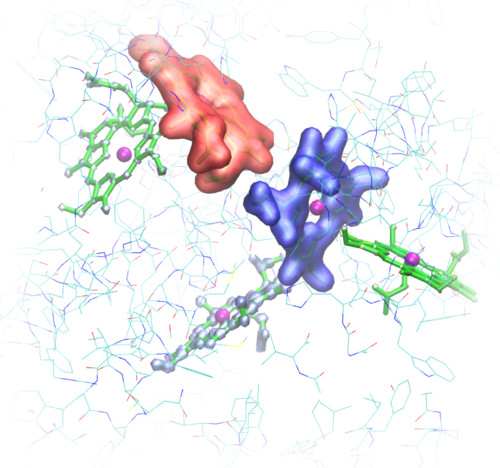Quantum/Classical Dynamics

Although quantum mechanics in principle offers a complete description of both electronic and nuclear dynamics, rigorous quantum theory is too computationally intensive for even the smallest biologically-relevant systems. Our group develops mixed quantum-classical methods to describe the vibrational dynamics of peptides and proteins and the electronic dynamics of photosynthetic pigment/protein complexes (PPCs). In the simplest case, the entire protein or PPC can be described classically, using molecular dynamics (MD) for conformational dynamics and a frequency-dependent polarizability for local vibrational or electronic transitions. We have recently demonstrated that such simple classical models can accurately describe a large variety of absorption and coherent energy-transfer processes typically thought of as quantum-mechanical. More advanced models must incorporate real quantum features into the dynamics, particularly the "energy funnel" effect that enforces energy flow from high-frequency to low-frequency sites.
A critical aspect of the group's research is that theoretical and computational models are developed and benchmarked directly against experimental spectroscopic measurements. This grounding in experimental reality in turn allows us to more confidentally apply our methods to unknown systems such as structurally-disordered peptides or spectrally-congested photosynthetic PPCs. Follow the links to learn more about these research areas or scroll down for publications related to quantum/classical dynamics.
Selected Publications
- Dutta, Rajesh; Reppert, Mike; "Quantum and classical effects in system-bath correlations and optical line shapes". Phys. Rev. A, 111, 022210 (2025).
- Dutta, Rajesh; Ma, Zifan; Fournier, Joseph A.; Reppert, Mike; "Nonlinear response from linear oscillators: Gas phase 2D action spectroscopy". The Journal of Chemical Physics, 163, 054113 (2025).
- Grechishnikova, Galina; Wat, Jacob H.; de Cordoba, Nicolas; Miyake, Ethan; Phadkule, Amala; Srivastava, Amit; Savikhin, Sergei; Slipchenko, Lyudmila; Huang, Libai; Reppert, Mike; "Controlling Vibronic Coupling in Chlorophyll Proteins: The Effects of Excitonic Delocalization and Vibrational Localization". The Journal of Physical Chemistry Letters, 15, 9456-9465 (2024).
- Ahad, S.; Lin, C.; Reppert, M.; "PigmentHunter: A point-and-click application for automated chlorophyll-protein simulations". The Journal of Chemical Physics, 160, 154111 (2024).
- Reppert, Mike; Dutta, Rajesh; Slipchenko, Lyudmila; "The interplay of excitonic delocalization and vibrational localization in optical lineshapes: A variational polaron approach". The Journal of Chemical Physics, 161, 154109 (2024).
- Reppert, Mike; Reppert, Deborah; "Equivalence of quantum and classical third order response for weakly anharmonic coupled oscillators". The Journal of Chemical Physics, 158, 114114 (2023).
- Reppert, Mike; Reppert, Deborah; "Diagrammatic approach to classical coherent two-dimensional infrared spectroscopy". Phys. Rev. A, 104, 033519 (2021).
- Reppert, Mike; "Delocalization Effects in Chlorophyll Fluorescence: Nonperturbative Line Shape Analysis of a Vibronically Coupled Dimer". The Journal of Physical Chemistry B, 124, 10024-10033 (2020).
- Reppert, Mike; Reppert, Deborah; Pachon, Leonardo A.; Brumer, Paul; "Equilibrium stationary coherence in the multilevel spin-boson model". Phys. Rev. A, 102, 012211 (2020).
- Reppert, Mike; Brumer, Paul; "Quantumness in light harvesting is determined by vibrational dynamics". J. Chem. Phys., 149, 234102 (2018).
- Reppert, Mike; Brumer, Paul; "Classical Coherent Two-dimensional Vibrational Spectroscopy". J. Chem. Phys., 148, 064101 (2018).